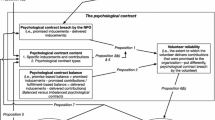Abstract
Spontaneous volunteers are ordinary citizens who assist in disaster relief efforts, while they are a great resource they also pose a difficult logistical challenge. Unlike classical labor assignment problems, the management of these volunteers is characterized by uncertainty regarding the size, availability, and commitment of the labor pool. We model this problem as a multi-server queueing system with both stochastic server arrival and abandonment. This model is intended to be applied to the relatively stable work associated with recovery efforts, e.g., debris clearing. We model this system as a continuous time Markov decision process and compare the optimal policy to several common-sense heuristics; one of which performs close to optimal and makes a practical alternative. We conduct extensive sensitivity analysis around model parameters and assumptions.



Similar content being viewed by others
Notes
In all cases examined, a discount factor of \(\alpha =0.03\) was used. This value was chosen because it is widely accepted in economic evaluation for developed countries and is recommended by the US Panel on Cost-Effectiveness in Health and Medicine (Siegel et al, 1997).
Details of the percentage of states for which the MDP policy matched the FV or LD policy for several examples can be found in Wolczynski (2015).
References
Akgun OT, Righter R, Wolff R et al. (2011). Multiple-server system with flexible arrivals. Advances in Applied Probability, 43(4):985–1004.
Alagoz O, Maillart LM, Schaefer AJ and Roberts MS (2004). The optimal timing of living-donor liver transplantation. Management Science, 50(10):1420–1430.
Altay N and Green WG (2006). OR/MS research in disaster operations management. European Journal of Operational Research, 175(1):475–493.
Andradóttir S, Ayhan H and Kirkizlar E (2012). Flexible servers in tandem lines with setup costs. Queueing Systems, 70(2):165–186.
Aramugam R, Mayorga ME and Taaffe KM (2009). Inventory based allocation policies for flexible servers in serial systems. Annals of Operations Research, 172(1):1–23.
Bertsekas DP (2007). Dynamic Programming and Optimal Control (3rd edn), vol 2. Belmont: Athena Scientific.
Caunhye AM, Nie X and Pokharel S (2012). Optimization models in emergency logistics: A literature review. Socio-Economic Planning Sciences, 46(1):4–13.
Coppola DP (2015). Introduction to International Disaster Management (3rd edn). Oxford: Butterworth-Heinemann.
Falasca M and Zobel C (2012). An optimization model for volunteer assignments in humanitarian organizations. Socio-Economic Planning Sciences, 46(4):250–260.
Fernandez L, Barbera J and Van Dorp J (2006). Strategies for managing volunteers during incident response: A systems approach. Homeland Security Affairs, 12, Article 9.
Galindo G and Batta R (2013). Review of recent developments in or/ms research in disaster operations management. European Journal of Operational Research, 230(2):201–211.
Glass TA (2001). Understanding public response to disasters. Public Health Reports, 116(Suppl 2):69–73.
Green L and Savin S (2008) Reducing delays for medical appointments: A queueing approach. Operations Research, 56(6):1526–1538.
Habib MS, Lee YH and Memon MS (2016). Mathematical models in humanitarian supply chain management: A systematic literature review. Mathematical Problems in Engineering. doi:10.1155/2016/3212095.
Hoyos MC, Morales RS and Akhavan-Tabatabaei R (2015). OR models with stochastic components in disaster operations management: A literature survey. Computers & Industrial Engineering, 82:183–197.
Johri PK (1989). Optimality of the shortest line discipline with state-dependent service rates. European Journal of Operational Research, 41(2):157–161.
Ke J-C, Lin C-H, Huang H-I and Zhang ZG (2011). An algorithmic analysis of multi-server vacation model with service interruptions. Computers & Industrial Engineering, 61(4):1302–1308.
Krishnamoorthy A, Pramod P and Chakravarthy S (2014). Queues with interruptions: A survey. TOP: An Official Journal of the Spanish Society of Statistics and Operations Research, 22(1):290–320.
Lassiter K, Alwahishie A and Taaffe K (2014). Improving volunteer productivity and retention during humanitarian relief efforts. International Journal of Supply Chain Management, 3(2):1–10.
Lassiter K, Khademi A and Taaffe KM (2015). A robust optimization approach to volunteer management in humanitarian crises. International Journal of Production Economics, 163:97–111.
Lodree E and Davis L (2016). Empirical analysis of volunteer convergence following the 2011 tornado disaster in Tuscaloosa, Alabama. Natural Hazards, 84(2):1109–1135.
Lowe S and Fothergill A (2003). A need to help: Emergent volunteer behavior after September 11th. In: Beyond September 11th: An Account of Post-Disaster Research (pp. 293–314). Boulder: University of Colorado Boulder.
Mayorga ME, Aramugam R and Taaffe KM (2009). Allocating flexible servers in serial systems with switching costs. Annals of Operations Research, 172(1):231–242.
Puterman ML (2005). Markov Decision Processes: Discrete Stochastic Dynamic Programming. Hoboken: Wiley.
Sampson SE (2006). Optimization of volunteer labor assignments. Journal of Operations Management, 24(4):363–377.
Siegel JE, Torrance GW, Russell LB, Luce BR, Weinstein MC, Gold MR et al. (1997). Guidelines for pharmacoeconomic studies. Recommendations from the panel on cost effectiveness in health and medicine. Panel on cost effectiveness in health and medicine. Pharmacoeconomics, 11(2):159–168.
Weber R (1978). On the optimal assignment of customers to parallel servers. Journal of Applied Probability, 15(2):406–413.
Winston W (1977). Optimality of the shortest line discipline. Journal of Applied Probability, 14(1):181–189.
Wolczynski J (2015). The Optimal Assignment of Spontaneous Volunteers. Master’s thesis, North Carolina State University, Raleigh, NC, USA.
Author information
Authors and Affiliations
Corresponding author
Rights and permissions
About this article
Cite this article
Mayorga, M.E., Lodree, E.J. & Wolczynski, J. The optimal assignment of spontaneous volunteers. J Oper Res Soc 68, 1106–1116 (2017). https://doi.org/10.1057/s41274-017-0219-2
Received:
Accepted:
Published:
Issue Date:
DOI: https://doi.org/10.1057/s41274-017-0219-2




